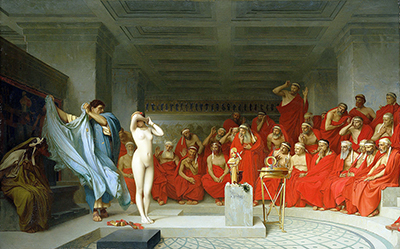Phryne was a strong woman who made a life for herself in the patriarchal world of ancient Greece, and, as so many other strong women do (even today) this brought disapprobation down on her from the (male) authorities.
She was a courtesan and a model for many beautiful pieces of art, including, it is said, Apelles's Aphrodite Rising from the Waves. She was tremendously wealthy and counted many notable men as her lovers – both factors that no doubt helped to sway the accusation that was levelled against her, a charge of impiety.
Impiety in those times was a serious offence, rather like heresy or blasphemy in Church-controlled nations, but the details of Phryne's alleged crime have been lost to history. What is known is that she was tried by the Areopagus which was the ancient Grecian equivalent of the Roman senate, a congregation of the leading men of the time. She was supported by one of her alleged lovers, the philosopher Hypereides, who, believing that the court was moving to find his lover guilty of the charge, whisked off her robe, displaying her breasts to the court.
So moved by her pale and delicate beauty – and possibly driven by a widespread belief at the time, that internal goodness and honour showed externally, making good people beautiful and bad ones ugly and deformed – were the court that they acquitted her of the charges. It is the point of Phryne being disrobed by Hypereides that Jean-Leon Gerome has depicted in this beautiful and evocative painting.
Phryne's robe, still fluttering away from her body, is the softest of pale baby blues, clearly made from a soft and delicate fabric, such as would befit a wealthy woman whose work involved the pleasures of the flesh. Her body is very pale, as white as alabaster, and this too is a signal that she is delicately reared – fairness was highly prized as it indicated that the person did not have to labour in the fields or even out of doors, risking sun burn and rough skin. The Aeropagus is dressed, universally, in vibrant red which contrasts beautifully with the pale blue robe and the whiteness of her skin.
The painting, simply entitled Phryne Before the Areopagus, was created in 1861 and is in oils on canvas. The painting measures 80.5 centimetres by 120 centimetres, and can be found hanging in the Hamburg Kunsthalle or 'art hall', one of the largest art museums in Germany.




